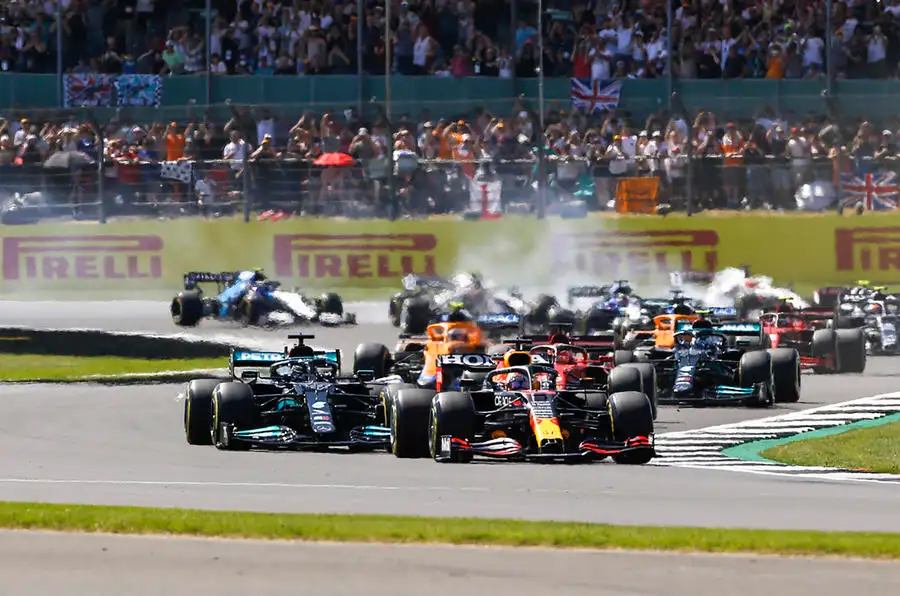The British Grand Prix runs at the Silverstone circuit. It is one of the oldest and most iconic circuits on the F1 calendar. The track is located near the Northamptonshire villages of Silverstone, Towcester and Whittlebury. Silverstone is on the site of a former World War II Royal Air Force airfield.
Silverstone hosted the first ever Formula One World Championship race in 1950. It has been the venue for the British Grand Prix more than 50 times since then. It is also a popular track for other racing series.
The British Racing Drivers’ Club owns it. Silverstone is a fast and flowing layout, with a mix of high-speed corners. It has long straights and technical sections that test the drivers’ skill and courage.
Here is a corner-by-corner guide to the 5.891 km circuit. It features 18 turns and a lap record of 1:27.097 set by Max Verstappen in 2020.
Silverstone GP – Track Layout and Key Features

Silverstone GP – Turn 1: Abbey
Abbey is a fast right-hander that marks the start of the lap. The drivers approach it at over 300 km/h and brake lightly to take it in seventh gear at around 260 km/h.
It is a slightly banked corner with a wide exit. It allowsthe drivers to carry a lot of speed onto the Farm Straight.
British Grand Prix – Farm
Farm is not really a corner, but a flat-out kink to the left that leads into Turn 3. The drivers stay on full throttle and reach speeds of over 320 km/h before braking hard for the next corner.
Silverstone GP – Village

Village is a tight right-hander that requires heavy braking and good traction. The drivers slow down to around 100 km/h and take it in second gear, aiming for a late apex and a smooth exit.
The corner is tricky because it has a downhill entry and an uphill exit, making it easy to lock up or run wide.
British Grand Prix – The Loop
This is a tight left-hand corner that was added in 2010, when the circuit layout was revised. It is the slowest corner on the track, taken at around 85-90 km/h in second gear.
The drivers stay in second gear and accelerate gently through the corner, trying to position the car for the next section. The Loop has a positive camber and a wide kerb on the inside, which can help the drivers to rotate the car.
The Loop is a good overtaking opportunity, as drivers can slipstream their rivals and out brake them into the corner.
Silverstone GP – Aintree
Aintree is a fast right-hander that exits onto the Wellington Straight. The drivers take it in fourth gear at around 180 km/h, using the full width of the track and clipping the apex kerb.
A good exit from Aintree is crucial for overtaking opportunities into Turn 6.
British Grand Prix – Brooklands
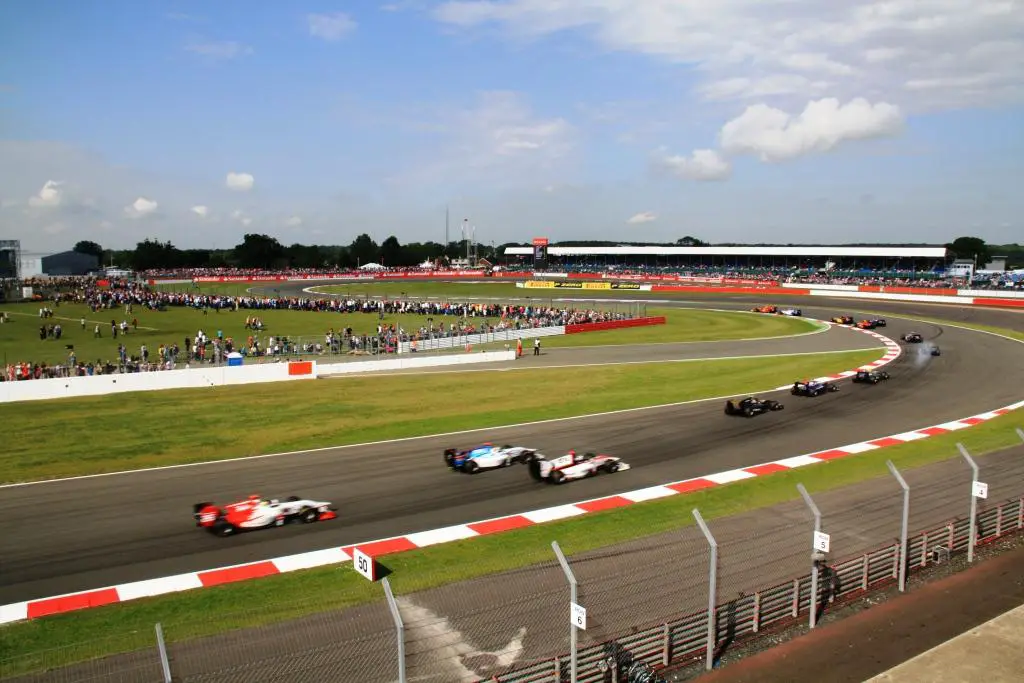
Brooklands is a medium-speed left-hander that requires late braking and precise steering.
The drivers slow down to around 140 km/h and take it in third gear, aiming for a late turn-in and an early exit. The corner has a negative camber and an off-camber exit, making it easy to understeer or run wide.
British Grand Prix – Luffield
Luffield is a long right-hander that follows Brooklands. The drivers stay in third gear and modulate the throttle through the corner, trying to find the best line and balance. Luffield has a decreasing radius and an uphill exit, making it difficult to get on the power early.
British Grand Prix – Woodcote
Woodcote is a fast right-hander that exits onto the old pit straight. The drivers take it in sixth gear at around 240 km/h, using the full width of the track and clipping the apex kerb.
Woodcote has a positive camber and a wide exit, allowing the drivers to carry a lot of speed onto the straight.
British Grand Prix – Copse

Copse is one of the fastest and most challenging corners on the F1 calendar. The drivers approach it at over 330 km/h and brake lightly to take it in eighth gear at around 290 km/h.
Copse is a blind right-hander with a slight bump on entry, making it easy to lose grip or run wide.
British Grand Prix – Maggotts-Becketts
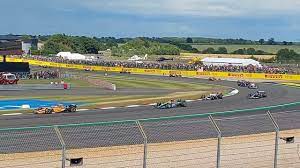
Maggotts-Becketts is a complex of four high-speed corners that form an S-shaped sequence. The drivers take them in seventh gear at around 250 km/h.
They change direction rapidly and using the kerbs as much as possible. Maggotts-Becketts is one of the most exhilarating and demanding sections on the F1 calendar, requiring precision, commitment and aerodynamic efficiency.
British Grand Prix – Chapel
Chapel is a fast right-hander that exits onto the Hangar Straight. The drivers take it in seventh gear at around 260 km/h, using the full width of the track and clipping the apex kerb.
Chapel has a positive camber and a wide exit, allowing the drivers to carry a lot of speed onto the straight. This is the last in a sequence of four high-speed corners that are taken between 235 and 310 km/h.
They are considered one of the most demanding and rewarding sections of any F1 track, as they test the drivers’ skill, concentration, and car balance.
The drivers have to change direction quickly and smoothly, while managing the lateral and vertical forces on their bodies and cars. The last corner, Chapel, is taken flat-out and leads to the longest straight on the track, the Hangar Straight.
British Grand Prix – Stowe
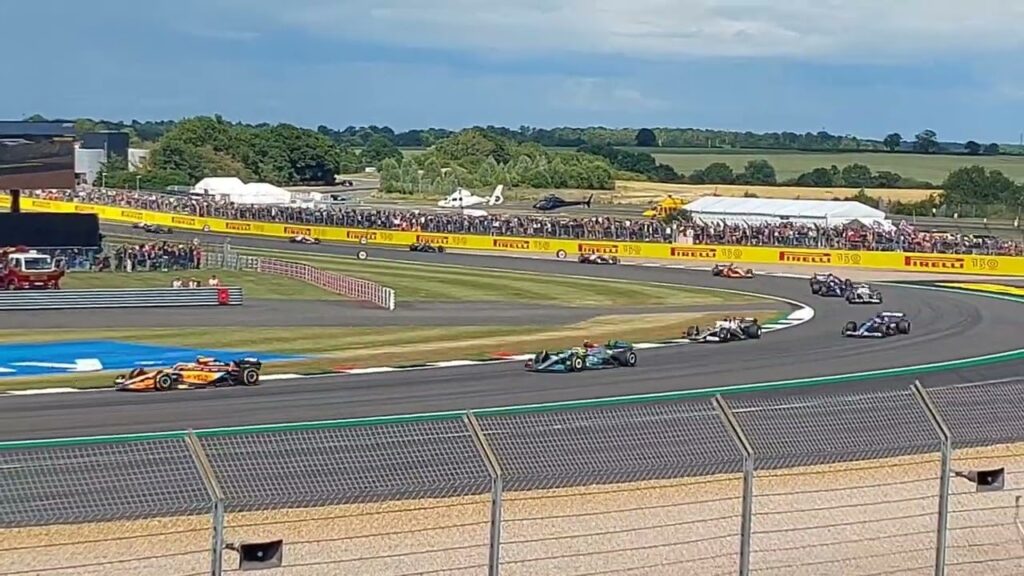
Stowe is a medium-speed right-hander that requires heavy braking and good balance.
The drivers slow down to around 160 km/h and take it in fourth gear, aiming for a late apex and a smooth exit.
Stowe has a downhill entry and an uphill exit, making it easy to lock up or run wide. This is a medium-speed right-hand corner that is taken at around 200 km/h in fourth gear.
It also has a lot of history, being the scene of some famous battles and incidents in F1 history, such as listed.
- Nigel Mansell’s pass on Nelson Piquet in 1987.
- Michael Schumacher’s broken leg in 1999.
- Lewis Hamilton’s puncture in 2020.
British Grand Prix – Vale
Vale is a tight left-hander that follows Stowe. The drivers slow down to around 100 km/h and take it in second gear, trying to position the car for the next corner.
Vale has a negative camber and an off-camber exit, making it easy to understeer or run wide. It is important to get a good exit from Vale, as it leads to Club, a long right-hand corner that opens up onto the start-finish straight.
British Grand Prix – Club
Club is a long right-hander that exits onto the new pit straight. The drivers stay in second gear and accelerate gently through the corner, trying to find the best line and traction.
Club has a decreasing radius and an uphill exit, making it difficult to get on the power early.
British Grand Prix – Abbey
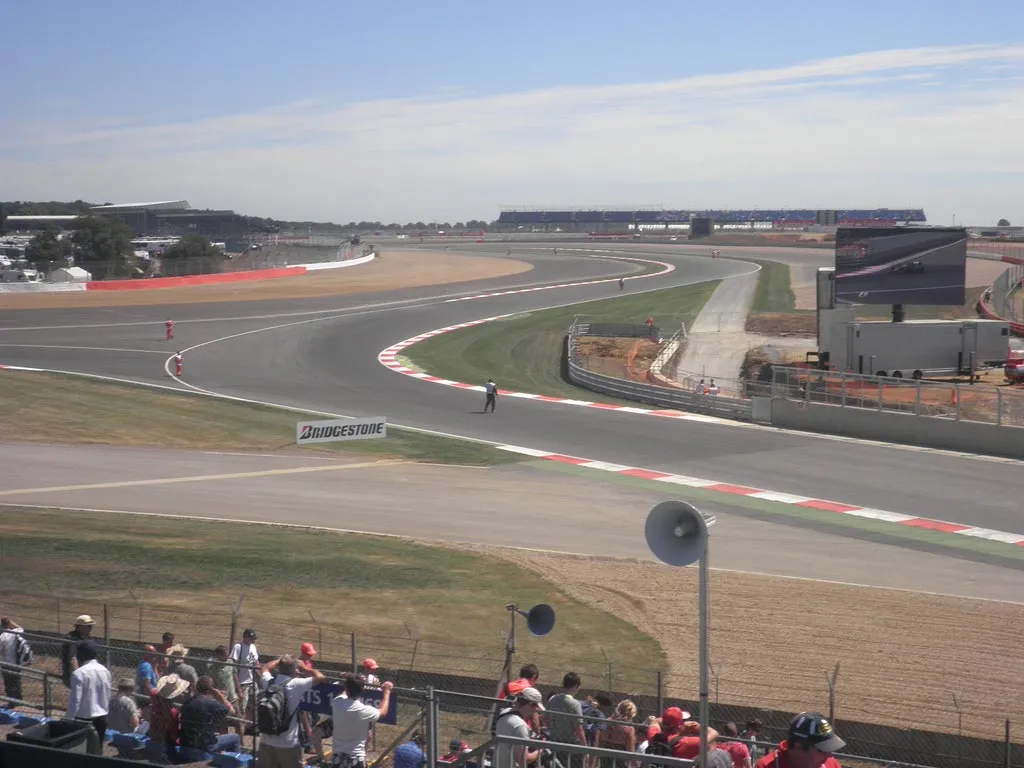
Abbey is the same as Turn 1, completing the lap. The drivers approach it at over 300 km/h and brake lightly to take it in seventh gear at around 260 km/h.
The corner is slightly banked and has a wide exit, allowing the drivers to carry a lot of speed onto the Farm Straight.

